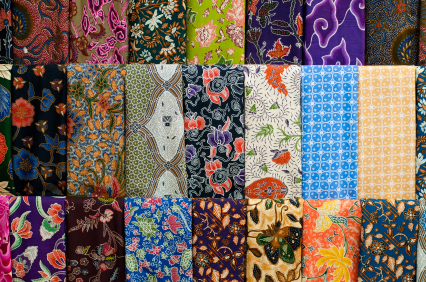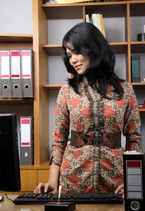INDONESIAN BATIK
|
When one thinks of batik the first thing that comes to mind is Indonesian batik. Although batik did not originate in Indonesia, it is an indisputable fact that batik reached its zenith in Indonesia and more specifically the island of Java. The word batik is most commonly believed to come from the word titik, which is a Javanese word that means dot or point.
It is believed that batik was introduced to the island of Java in the 6th or 7th century although it is hard to pinpoint the exact date because the use of batik on Java predates the island’s recorded history. |
Traditional batik colors were indigo, dark brown and white and represented the three major Hindu gods of Brahma, Vishnu and Siva. Sometimes batik fabric was decorated with gold leaf for special occasions. This practice was most common on the island of Java and was called prada, which is the Javanese word for gold.
In Indonesia batik fabric was originally sold in 2.25m lengths to make sarongs or kebaya dresses. Batik fabric was also used in hats called blangkon and even slings for carrying children. The Indonesians had specific designs that identified families and royalty. There was also a special Javanese ceremony, called naloni mitoni, which celebrated a woman’s first pregnancy by wrapping her in seven layers of batik with special designs for the occasion. There were even specific designs reserved for weddings and funerals.
In Indonesia batik fabric was originally sold in 2.25m lengths to make sarongs or kebaya dresses. Batik fabric was also used in hats called blangkon and even slings for carrying children. The Indonesians had specific designs that identified families and royalty. There was also a special Javanese ceremony, called naloni mitoni, which celebrated a woman’s first pregnancy by wrapping her in seven layers of batik with special designs for the occasion. There were even specific designs reserved for weddings and funerals.
|
While the use of batik clothing in Indonesia has waned over the years due to mass production and desire for more western style attire efforts are being made to ensure that the art of batik is not lost in Indonesia. Indonesian fashion designers have been making a concerted effort to incorporate batik into their designs. Many professional offices in Indonesian have declared Friday as a to wear batik instead of regular business attire. Even the flight attendants for the state run Indonesian airlines have batik print designs incorporated into the skirt of their kebaya uniform.
|


